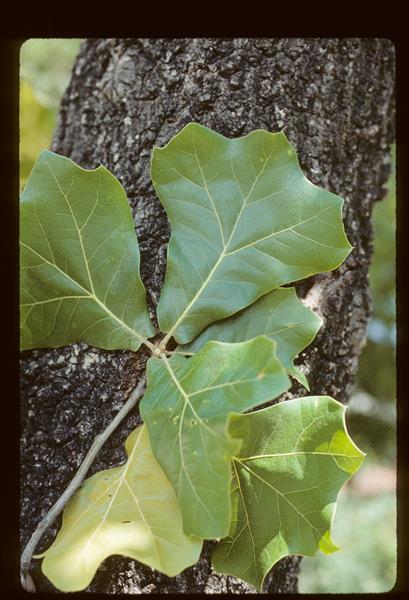
Origin/Endemic status: Native
Other Comments: There are historical accounts of the existence of prairies or barrens in the vicinity of Charlotte in the late eighteenth century, known as the "the blackjack lands". These areas were described as open and prairie-like, until the early nineteenth century, when they became dominated by dense forests of blackjack oak. The previously open condition was almost certainly maintained by fire, perhaps set by the Waxhaw Indians. Blackjack oak has long been considered an indicator of ‘poor’ soil (from an agricultural perspective), as in Guthrie (1820), who states in his discussion of NC, "the Black Jack land is generally poor, … and is avoided by farmers, as unproductive".
Synonymy: = Ar, K1, NY, Va, Hunt (1990); < Quercus marilandica Münchh. – C, F, Fl2, FNA3, G, GrPl, Il, K3, K4, NcTx, Pa, RAB, S, Tat, Tn, Tx, W, WH3, WV; < Quercus marylandica Münchh. – S13
Heliophily: 8
Hover over a shape, letter, icon, or arrow on the map for definition or see the legend.
 © Bruce A. Sorrie | Original Image ⭷
© Bruce A. Sorrie | Original Image ⭷ © Scott Ward | Original Image ⭷
© Scott Ward | Original Image ⭷ © Keith Bradley | Original Image ⭷
© Keith Bradley | Original Image ⭷ © J.W. Hardin | Original Image ⭷
© J.W. Hardin | Original Image ⭷ © Alan Weakley source | Original Image ⭷
© Alan Weakley source | Original Image ⭷ © Alan Weakley source | Original Image ⭷
© Alan Weakley source | Original Image ⭷ © Alan Weakley source | Original Image ⭷
© Alan Weakley source | Original Image ⭷Feedback
See something wrong or missing on about Quercus marilandica var. marilandica? Let us know here: (Please include your name and email if at all complicated so we can clarify if needed.)
Cite as...